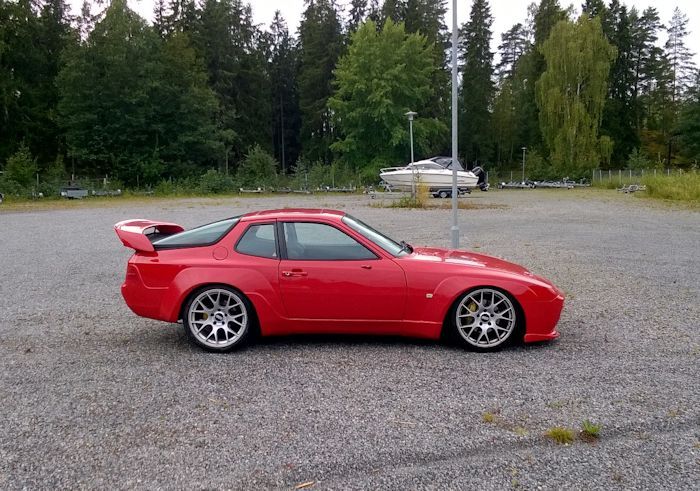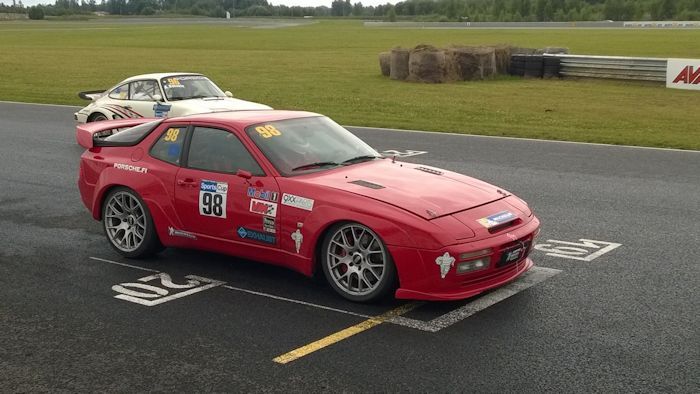LINDSEY WASTEGATE INSTALLATIONQUICK INTROThe following is our on-line tutorial on how to "do it yourself" install the Lindsey Racing 944 Turbo (951) wastegate. Porsche used two different styles of wastegates on the 944 turbo. As far as we have been able to confirm, the '86 and '87 used one style and the '88 and newer used the other. The difference is in the hot housing's outer dimensions. The cooling fins on the '86/'87 are larger and the portion of the housing where some bolts pass through to attach to the mounting bracket is thicker. They are completely interchangeable but the bolt length issue will come up if you install one different than the one that came out of your car. Our wastegate comes with both bolt lengths to allow you to use either wastegate style, so it's not a big issue. Pictured are two different styles of the Lindsey Racing wastegate. The difference only being in the hot housing.   If you install an '88 and newer style where there was an '86/'87, you will discover the three Allen bolts that attach the bracket to the wastegate will be too long and hit the cooling fin on the new diaphragm housing. If you install an '86/'87 style where there was an '88 and newer, you will discover that the bolts are too short and will barely catch the threads. Use the appropriate supplied bolts. We would like you to order the one that your car has now, but this is not required. You can confirm which one you have by using a flashlight and shining down at the back of the engine on the right side, up against the firewall, and inspecting the fin area. The differences are very obvious. When using a dual port wastegate (such as this one) on the 944 turbo, and controlling it with either a single, 2 stage or electronic boost controller, you "do not" use the cyclic valve. Using the cyclic valve will result in un-controllable boost levels. This is, of course, not good. In the last step, we will show you how to deal with the old lines to the cyclic valve. It may at this point look like it's a long process, but it's not. The following steps can be very short and most are. First timers can expect to take 1-2 hours. When you get to the next frame, we recommend you read the whole step before you perform it. The wastegate we are removing in this illustration is one of our prototype dual ports. It is the same as the stock piece other than the diaphragm housing. We are also removing a style '88 and installing a style '86/'87. The removal of the factory wastegate is identical. So pretend it is the original one. Don't let all this confuse you. We just wanted to let you know what things seem a little different than you will be encountering. STEP 1 Raise the front of the car in the air and support with jack stands. Do not get underneath your car without jack stands or some other approved support. Remove the 5 10mm bolts holding the aluminum shield behind the oil pan. This exposes the wastegate completely. STEP 2 Remove the 4 13mm bolts attaching the wastegate to the outlet pipe. (RED) Remove the 3 10mm bolts attaching the wastegate to the crossover pipe. (GREEN) STEP 3 Remove the 2 13mm bolts attaching the wastegate mounting bracket to the drive shaft tube mount. These are located way up top about 4 inches above the wastegate and face backward. (RED) We remove the bracket from the wastegate once it is out. The bolts are too difficult to access in the car.  What works best for this is a long extension, or couple several together to equal about 18 inches. You will need a swivel socket. The chrome works better than the impact type. A 1/2" will work if you don't have a metric one. Loosen the clamp on the hose at the top of the diaphragm housing. Slip the hose off the fitting. Now it is time to remove the wastegate. You may need to tap on the wastegate lightly on the side port flange to jar it loose from the exhaust outlet pipe. Rotate as necessary and lower down from the car. STEP 4 This is the old wastegate after removal. There is a doughnut style gasket on the inlet pipe which would be left on the car. There is a metal crush ring gasket on the wastegate outlet pipe. Our experience so far, even after changing the wastegate on this car many times, is that the gaskets are re-usable. For the price of the new ones, you may want to replace them for assurance that there are no exhaust leaks. Remove the 3 6mm allen bolts holding the wastegate to the mounting bracket (RED) and install the same parts and bolts on the new wastegate. Remove the exhaust inlet pipe by removing the 4 13mm nuts with washers. (GREEN) A little WD-40 works well here. If the stud comes out with the nut, remove the nut from the stud because we will be re-using the nuts. The new wastegate has studs already.  Here we see the new wastegate with the mounting bracket and inlet pipe installed. We also install the hose barb fittings on the pressure and control port. Use Teflon tape on the threads. Note the proper orientation of the inlet pipe to the wastegate. It only works one of the four possible ways you could install it. STEP 5 Raise the wastegate back up into position. Rotate as necessary to get into place. Replace the 4 bolts connecting the wastegate to the outlet pipe first. (RED) Replace the 2 13mm bolts holding the wastegate mounting bracket to the driveshaft tube bracket. (out of sight) Replace the 3 10mm bolts holding the wastegate inlet pipe to the crossover pipe. (GREEN) We assume at this point you have the boost controller installed and are ready to connect the two lines. Connect the boost pressures line (from the banjo bolt) to the top port on the wastegate. (YELLOW) Connect the control line from the regulator to the side port on the wastegate. (BLUE) STEP 6 Installing a dual port wastegate and boost controller eliminates the use for the cyclic valve which is located under the intake manifold at the back. We need to address the old lines attaching it. The metal line coming out from under the front of the intake manifold that used to be attached to the banjo bolt can be left alone and un-plugged. (RED) The line from the cycling valve to the old wastegate can be left alone. The rubber hose that used to connect to the second metal line (YELLOW) coming out from under the intake manifold (GREEN) needs to be plugged. Otherwise we have an intake air leak. You can leave the metal line open.  Another option for this hose is to remove it and plug at the intake boot by cutting the clamp and pulling it out. (BLUE) You can slide a bolt or some other similar plug into the hole and install a hose clamp to secure it. You will need to remove the intercooler pipe (WHITE) to access it. This completes the installation of the wastegate. |
Secure Checkout



